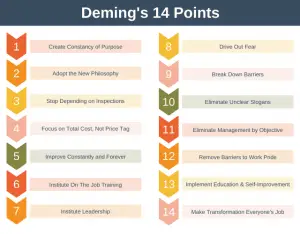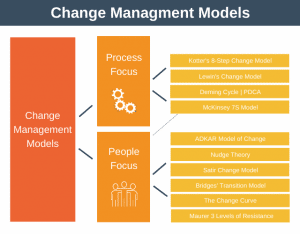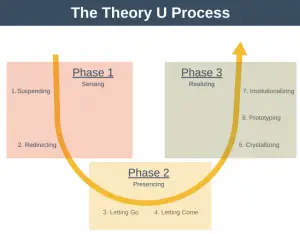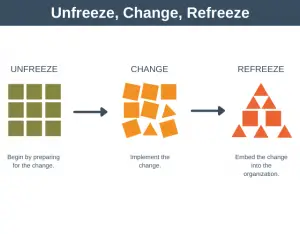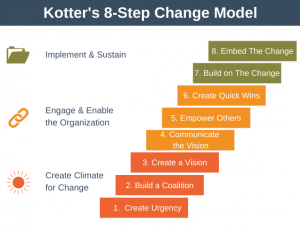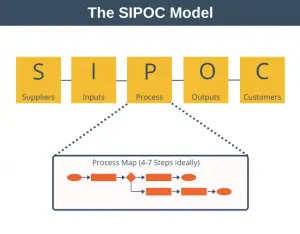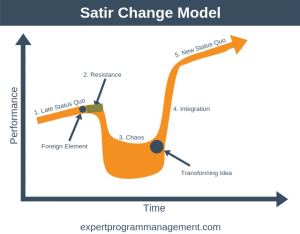Nudge Theory is based on the idea that people can be nudged to make the right choice without coercing them or restricting their freedom of choice.
Nudging differs from other ways to achieve compliance because the individual maintains their freedom of choice and is in control of any decisions they make.
Background
Nudge Theory was popularized in the 2008 book ‘Nudge – Improving Decisions about Health, Wealth and Happiness‘ by Richard Thaler and Cass Sunstein.
It is disputed whether “nudge theory” is a new development in behavioral economics or simply a new term for a set of methods and techniques for influencing behavior that have existed for much longer.
If you’re reading this article, you probably think of yourself as a logical and rational individual, making independent choices to solve problems as they arise throughout your working day.
However, is the truth a little more complex? Psychologists have long known that humans make decisions using two systems:
- The automatic system: a fast, intuitive system providing an automatic or emotional response.
- The reflective system: a slower system requiring deliberate conscious thought.
When you learn to drive, you’ll use the reflective system to help you learn the new skill, but once you’ve learned to drive, you’ll hand the skill over to the automatic system, so it no longer requires much thought.
It takes a lot of effort to use your reflective system, and as humans are inherently lazy, we all try to use our automatic system where possible.
One problem with using our automatic system to make decisions is that we’re inclined to make irrational decisions because of deep-rooted biases such as the fear of standing out from the crowd. You can think of biases as heuristics (rules of thumb) to help you make quick decisions.
Quickly read the text contained in the triangle below:
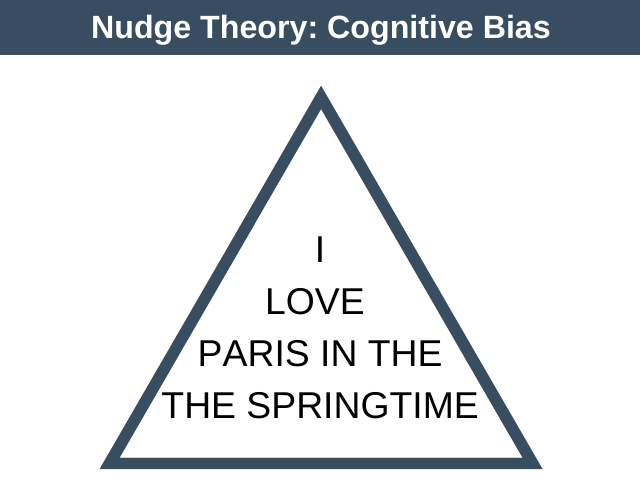
The majority of people don’t notice the second “the” when they read the text for the first time. If you did the same, that’s because you’re using a mental shortcut to read the text rather than using your reflective system. The purpose of this example is to show you that every one of us has cognitive biases.
Thaler and Sunstein list five biases that prejudice our decision making:
1. Anchoring
Anchoring occurs when you rely too much on one piece of information. When making plans or decisions, you interpret new information from the reference point of your anchor instead of viewing it on its own merits.
For example, when shopping in a fancy store, the first t-shirt you look at costs $1,000. If the next t-shirt you look at in that store costs $100 you’re prone to thinking of it as cheap, even if you’d never normally pay anywhere near that amount for a t-shirt. In this case, you have been anchored by the $1,000 price tag.
2. Availability heuristic
Availability heuristic bias is a mental shortcut whereby you rely too much on immediate examples that spring to mind when evaluating a topic.
For example, although car travel has higher mortality than air travel statistically, many people who happily undertake car journeys can be scared of plane travel. This is because plane crashes are more widely covered in the media and are thus more easily recalled than car crashes.
3. Representativeness heuristic
Representativeness heuristic bias is a mental shortcut you use when estimating probabilities. You compare the outcome under consideration to an existing prototype in your head, which is what you think is a typical example of a particular event or object. You assume the outcome and your prototype are more closely related than they actually are.
For example, consider this sentence:
Lucy is 26 and has just graduated from Harvard Business School with an MBA, where she was also passionate about gay rights.
Is it more likely that A. Lucy works in a bank, or B. Lucy works in a bank and is actively involved in the gay rights movement?
Most people opt for answer B. This is incorrect, and they’ve been influenced by representativeness heuristic bias. In fact, answer B is a subset of answer A. Because of this, it can’t be more probable than answer A. That is, the odds of Lucy being within a narrower subset (bank employees active in gay rights) must be statistically lower than the odds of her being in the larger group (bank employees).
4. Status quo bias
Status quo bias is an unconscious bias towards the current state of affairs where any move away from this is perceived as a loss. This cognitive bias prefers inaction to action, even when action is the more favorable decision.
For example, you own a small company with a considerable cash surplus sitting in a deposit account. Rather than invest the money to grow your business, you stick with the default option of leaving the money where it is. It is easier for your automatic system to decide to do nothing than for your reflective system to determine how to invest the money.
5. Herd mentality
Herd mentality is a mental shortcut you use whereby you copy and follow what others are doing.
For example, suppose you’re walking down an unfamiliar street looking for a restaurant to have dinner. You see a virtually empty restaurant but decide to keep looking before eventually selecting a busier restaurant. Your selection has been made because you’ve assumed the restaurant you’ve chosen is better because there a more people there.
This is the herd mentality bias in action.
Nudge Theory
The power of nudge theory is that it taps into your irrational biases and heuristics to nudge you towards making a particular decision.
It does this without resistance and confrontation common to other more autocratic methods of changing people’s behavior.
Let’s look at some examples of nudges from the workplace.
Nudge Example 1
Desired Behavior: Encourage employees to meet new people outside their immediate team.
Nudge: Create a single cafeteria for the entire organization, with long tables to encourage people from different departments to sit together and strike up conversations.
Nudge Example 2
Desired behavior: Encourage employees to print less, reducing ink and paper usage.
Nudge: Remove printers from all but one room of the building. Everybody can use this printer, but most will have to walk some distance to collect their printout.
Nudge Example 3
Desired behavior: Encourage people to send you their monthly reports on time.
Nudge: Email your team three days before the report is due, letting the entire team know that 80% (or whatever the actual figure is) of the team have already sent you their report. This leverages the herd mentality bias to encourage others to send you their reports.
Nudge Theory Process
If you’ve read this far, you probably think that nudge theory sounds great in theory, but how do you use it in practice? For this, we offer the following simple Nudge Theory Process to help you create your own nudges.
When using this process, you’ll essentially become a choice architect, responsible for setting the context with which your people make decisions.
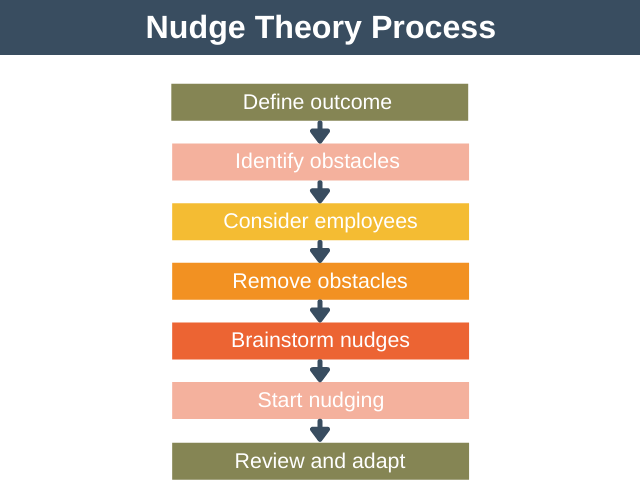
The steps of the process are:
1. Define the outcome
Define what it is you are trying to achieve and why. Don’t aim initially for a huge goal; instead, try to start small and build on any success you have.
2. Identify obstacles and unhelpful existing nudges
Brainstorm if any obstacles or existing negative nudges prevent your team from exhibiting your desired behavior.
3. Consider the employees’ perspective
Consider the benefits to your employees of making this change. Consider asking your employees to participate in designing the nudge.
4. Remove obstacles and existing negative nudges
If feasible, remove any obstacles and existing negative nudges you have identified in step two.
5. Brainstorm nudges
Brainstorm to identify a set of possible nudges, leveraging cognitive biases to make it easy for people to display the right behavior.
6. Start nudging
Select one or more nudges and begin nudging.
7. Review and adapt
Measure success against your desired outcome and adapt as necessary. Remember to take on board feedback from employees.
Nudge Theory Process Example
Imagine you are a senior manager responsible for an office-based team of employees. You want to increase productivity, in particular, by increasing the amount of deep, concentrated work that gets done.
Let’s take a look at what each of the Nudge Theory Process steps might look like for this example.
1. Define the outcome
Increase productivity by enabling people to carry out more deep work.
2. Identify Obstacles and unhelpful existing nudges
Distractions are everywhere, from people initiating office chats directly to a constant stream of optional meetings for people to attend.
3. Consider the employees’ perspective
It’s annoying for employees when they are trying to concentrate, and there are so many distractions. It probably impacts job satisfaction too.
4. Remove obstacles and existing negative nudges
It’s challenging to remove the current issues without negatively impacting how others like to work.
5. Brainstorm nudges
You identify two nudge ideas. The first is introducing partitions between the desks to make it harder for employees’ to initiate chit-chat. You rule out this idea. After all, it isn’t actually a nudge because it’s not optional and would make it harder for all employees to converse, which you don’t want.
The second idea is to introduce a trophy. When a person puts the trophy on their desk, it means they are trying to do deep work and should not be disturbed under any circumstances. This idea builds on the herd mentality bias: once some of the team start observing the rules of the trophy, the rest should follow.
6. Start Nudging
You introduce the trophy nudge to the team.
7. Review and Adapt
The team is using the trophy as intended; however, the team feedback is that it’s still hard to concentrate as people are striking up conversations around them while they are trying to do deep work.
We train the team that when someone has the trophy on their desk, they should not strike up conversations with others in close vicinity.
Nudge Theory Change Management
Whilst Nudge Theory can be used to change people’s behavior it isn’t a fully-fledged change management model.
Instead, it is a tool that can be used within any formal change management model, such as the ADKAR Change Management Model or Kotter’s 8-Step Change Model, to nudge employees towards the desired behaviors.
Summary
Nudge Theory is based on the idea that people can be nudged to make the right choice without coercing them or restricting their freedom of choice.
It is based on the idea that you can leverage biases inherent in every human being to nudge people towards exhibiting the desired behavior.
